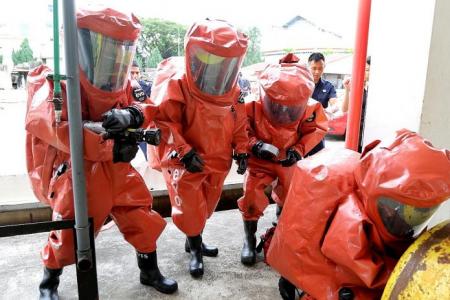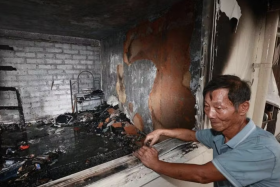SCDF officer at chlorine gas leak: 'It felt like a movie'
On Sunday, seven people were taken to hospital after a chlorine gas leak in Tuas. CYNTHIA CHOO (chooxlc@sph.com.sg) speaks to the SCDF team which plugged the leak, and tries on a Hazmat suit
When Singapore Civil Defence Force (SCDF) second warrant officer (2WO) Zul Faizal, 34, entered the warehouse where the leak had occurred, he felt as if he had walked into a movie.
Speaking to The New Paper on Wednesday at the Civil Defence Academy in Jalan Bahar off Lim Chu Kang Road, he said: "I thought I was on a movie set.
"The only source of light shone through the shutters of the windows."
Yellow chlorine fumes engulfed the side door entrance and carpeted the floor.
2WO Faizal was part of a four-man hazardous materials (Hazmat) team deployed to plug a chlorine gas leak on Sunday at about 9.20am.
As he was wearing a chemical protective suit, the only sound 2WO Faizal could hear was his breathing.
LOW VISIBILITY

He said: "Visibility was low, which made the task even more challenging."
His vision was also blurred as he had to wear an oxygen mask underneath the suit's visor.
If not for the suit, 2WO Faizal and his men could have suffered breathing difficulties, eye irritation and blisters on their skin.
The toxic chlorine gas could also cause fluid to build up in their lungs when exposed to it for prolonged periods.
The chlorine gas leak happened in Chemical Industries (Far East) at Jalan Samulun.
Seven people, including two SCDF officers, were taken to Ng Teng Fong General Hospital in three ambulances.
The Hazmat specialists were able to plug the leaking valve in under 20 minutes.
With the help of suppression jets that diffused the chlorine gas, the team spotted a stream of gas gushing out of a leaking valve among some 100 cylinders in the warehouse.
2WO Faizal and his team got to work.
First, they screwed on a replacement cylinder cap over the cracked valve and secured it with duct tape.
Then, they sealed the valve with putty paste.
The specialists were not always so nimble.
Sergeant Syukri Johari, 25, who was part of the team, said: "When I first started training, the stiff rubber gloves on the suit made holding even a pen difficult."
The specialists had to go through a three-week course to understand the risks of chemical hazards. They also have to pass a certification test every six months.
Major Huang Weikang, 33, commander of Tuas View Fire Station, who was at the scene on Sunday, said: "People may not understand the risks of dealing with hazardous materials because often, these chemicals are gaseous and cannot be seen.
"They understand fire is dangerous because they can see the flames and the smoke.
"But chemical hazards can be equally, if not more, dangerous."
People may not understand the risks of dealing with hazardous materials because often, these chemicals are gaseous and cannot be seen.
- Major Huang Weikang, commander of Tuas View Fire Station
You can only hear your breathing in this suit


It takes a Singapore Civil Defence Force (SCDF) hazardous material (Hazmat) specialist only four minutes to don a chemical protective suit.
But when I tried to put on a suit on Wednesday, it took me more than 15 minutes, and that was with the help of two SCDF officers.
The rubberised suit, used in operations that involve hazardous chemicals like chlorine gas, protects Hazmat specialists from toxic chemicals in solid, liquid and gas form.
First, I had to strap on a breathing apparatus (BA) that weighed about 15kg. It was linked to an oxygen mask that completely blocked out external gases.
I stumbled to get in, fumbled for the hand and leg openings, and had to hold on to the SCDF officers while doing so.
The moment I was zipped up, I began to sweat profusely. Being inside the suit was akin to being in an echo chamber.
It was stifling and humid. I could hear the laboured breaths I took with every step.
My short, sharp gasps reverberated in my ears and at one point, I felt like I was hyperventilating.
But no one would have heard me even if I shouted. I was cut off from any communication with the outside world.
Doing pretty much anything in the suit was hard, given the weight of the ensemble.
Walking around was a chore and I was limited to just moving my arms as I stood upright. I had lost all dexterity due to the rubber gloves that were part of the suit and was too embarrassed to even try to grab an object.
TRAINING COURSE
Major Abdullah Abu Bakar Bafadhal said: "Not everyone can be a Hazmat specialist."
Hazmat specialists go through an interview before they are selected to attend a three-week training course.
Maj Abdullah said: "We look at their years of experience in the service, fitness level and ability to work in claustrophobic environments.
"We also want people who are able to think on their feet because a Hazmat incident can be dynamic, often requiring Hazmat specialists to quickly adapt to a changing situation while employing different techniques and equipment to mitigate the incident."
Hazmat specialists also have to learn to control their breathing to be able to last up to 45 minutes on a single breathing apparatus.
With the heavy breaths I took, I would have depleted the air supply in half the time.
It was a humbling experience and I was glad to get out of it with newfound respect for these specialists who put themselves in harm's way at a moment's notice.
Get The New Paper on your phone with the free TNP app. Download from the Apple App Store or Google Play Store now


